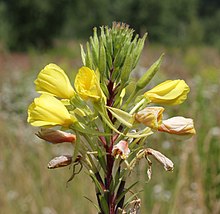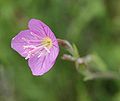Oenothera
Oenothera is a genus of about 145[3] species of herbaceous flowering plants native to the Americas.[4] It is the type genus of the family Onagraceae. Common names include evening primrose, suncups, and sundrops. They are not closely related to the true primroses (genus Primula).
Description
The species vary in size from small alpine plants 10 centimeters tall, such as O. acaulis from Chile, to vigorous lowland species growing to 3 meters, such as O. stubbei from Mexico. The leaves form a basal rosette at ground level and spiral up to the flowering stems. The blades are dentate or deeply lobed (pinnatifid). The flowers of many species open in the evening, hence the name "evening primrose". They may open in under a minute. Most species have yellow flowers, but some have white, purple, pink, or red. Most native desert species are white. Oenothera caespitosa, a species of western North America, produces white flowers that turn pink with age.[5] One of the most distinctive features of the flower is the stigma, which has four branches in an X shape.[6]
Ecology
Oenothera flowers are pollinated by insects, such as moths and bees. Like many other members of the Onagraceae, however, the pollen grains are loosely held together by viscin threads, so only insects that are morphologically specialized to gather this pollen can effectively pollinate the flowers. Bees with typical scopa cannot hold it. Also, the flowers open at a time when most bee species are inactive, so the bees which visit Oenothera are generally vespertine temporal specialists: bees that forage in the evening. The seeds ripen from late summer to fall.
Oenothera are used as food plants by the larvae of some Lepidoptera species. The flower moths Schinia felicitata and S. florida both feed exclusively on the genus, and the former is limited to O. deltoides.
In the wild, evening primroses act as primary colonizers, quickly appearing in recently cleared areas. They germinate in disturbed soils, and can be found in habitat types such as dunes, roadsides, railway embankments, and waste areas. They are often casual and are eventually outcompeted by other species.
Origin
The genus Oenothera may have originated in Mexico and Central America,[7][8] and spread farther north in North America and into South America. With the advent of international travel, species are now found in most temperate regions of the world. In Europe alone there are about 70 introduced species of Oenothera.[4] During the Pleistocene era a succession of ice ages swept down across North America, with intervening warm periods. This occurred four times, and the genus experienced four separate waves of colonization, each hybridizing with the survivors of previous waves.[8][9] This formed the present-day subsection Euoenothera. The group is genetically and morphologically diverse and the species are largely interfertile, so the species boundaries have been disputed amongst taxonomists.[7][10]
This pattern of repeated colonizations resulted in a unique genetic conformation in the Euoenothera whereby the chromosomes at meiosis can form circles rather than pairs. This is the result of several reciprocal translocations between chromosomes such that the pairing occurs only at the tips. This phenomenon apparently has non-Mendelian genetic consequences; with this mode of chromosome segregation and a system of balanced-lethal genes, genetic recombination is prevented and the plants display the hybrid vigor of heterosis.[11] This resulted in the evolution of many sympatric races in North America east of the Rocky Mountains. Analysis of the cytology of these races and of artificial hybrids between them increased understanding of the genetic and geographic evolution of the Euoenothera. This subject was a major area of genetic research during the first half of the 20th century.[12][13]
Taxonomy
Evening primroses were originally assigned to the genus Onagra, which gave the family Onagraceae its name. Onagra (meaning "(food of) onager") was first used in botany in 1587, and in English in Philip Miller's 1754 Gardeners Dictionary: Abridged. The modern name Oenothera was published by Carolus Linnaeus in his Systema Naturae. Its etymology is uncertain, but is believed to be derived from the Greek words ονος θηρας (onos theras), meaning "donkey catcher", or οινος θηρας (oinos theras), meaning "wine seeker".[14] In addition, the Latin oenothera means "a plant whose juices may cause sleep".[15]
In 1905, while studying the genetics of Oenothera lamarckiana, Hugo de Vries discovered a variant with a chromosome number of 2n = 28 compared with 2n = 24 for O. lamarckiana. DeVries was unable to breed this variant with O. lamarckiana. He named the variant Oenothera gigas.[16]
Evidence of medical effects
Certain Oenothera plants have edible parts. The roots of O. biennis are reportedly edible in young plants.[17]
There is very little evidence for any effectiveness of primrose oil as a cancer treatment according to the American Cancer Society, and "neither GLA nor other GLA-rich supplements (such as evening primrose oil) have been convincingly shown to be useful in preventing or treating any other health conditions."[18] A Cochrane meta-analysis published in April, 2013, found evening primrose oil capsules and borage oil to be ineffective for eczema.[19]
Most research indicates that evening orally administered primrose oil does not relieve symptoms premenstrual syndrome.[20][21]
Neither does orally administered primrose oil seem have any effect in shortening the length of pregnancy or labour.[22][23][24][25]
Cultivation
A number of perennial members of the genus are commonly cultivated and used in landscaping in the southwestern United States. Popular species include tufted evening primrose (Oenothera caespitosa), Mexican evening primrose (Oenothera berlanderii), and Saltillo evening primrose (Oenothera stubbei).[26]
Annual evening primroses are also popular ornamental plants in gardens. Many are fairly drought-resistant.
The first plants to arrive in Europe reached Padua from Virginia in 1614 and were described by the English botanist John Goodyer in 1621. Some species are now also naturalized in parts of Europe and Asia, and can be grown as far north as 65°N in Finland. The UK National Council for the Conservation of Plants and Gardens, based at Wisley, maintains an Oenothera collection as part of its National Collections scheme.
Gallery
-
Oenothera caespitosa var. marginata
-
Oenothera stricta ssp. stricta
-
Oenothera sp. opening
-
Oenothera clelandii
-
Oenothera drummondii
References
- ^ "Genus: Oenothera L". Germplasm Resources Information Network. United States Department of Agriculture. 2004-03-22. Retrieved 2010-10-28.
- ^ "GRIN Species Records of Oenothera". Taxonomy for Plants. USDA, ARS, National Genetic Resources Program. Retrieved July 11, 2010.
- ^ Singh, S.; et al. (2012). "An updated review on the Oenothera genus" (PDF). J. Chin. Integr. Med. 10: 717–25. doi:10.3736/jcim20120701.
{{cite journal}}: Explicit use of et al. in:|last2=(help) - ^ a b Mihulka, S.; Pyšek, P. (2001). "Invasion history of Oenothera congeners in Europe: a comparative study of spreading rates in the last 200 years" (PDF). Journal of Biogeography. 28 (5): 597–609. doi:10.1046/j.1365-2699.2001.00574.x.
- ^ Gumbo Lily (Oenothera caespitosa). Native Wildflowers of the North Dakota Grasslands. USGS Northern Prairie Wildlife Research Center.
- ^ Peterson, R. T. and M. McKenny (1968). A Field Guide to Wildflowers of Northeastern and North-central North America. Boston: Houghton Mifflin. ISBN 0-395-91172-9.
- ^ a b Raven, P. H.; et al. (1979). "An outline of the systematics of Oenothera subsect. Euoenothera (Onagraceae)". Systematic Botany. 4 (3). Systematic Botany, Vol. 4, No. 3: 242–252. doi:10.2307/2418422. JSTOR 2418422.
- ^ a b Dietrich, W.; et al. (1997). Systematics of Oenothera section Oenothera subsection Oenothera (Onagraceae). Laramie: The American Society of Plant Taxonomists. ISBN 0-912861-50-9.
- ^ Cleland, R. E. (1972). Oenothera - Cytogenetics and evolution. Boston: Academic Press. ISBN 0-12-176450-8.
- ^ Rostanski, K. (1985). "The classification of subsection Oenothera (section Oenothera, Oenothera L., Onagraceae)". Feddes Report. 96 (1–2): 3–14. doi:10.1002/fedr.4910960103.
- ^ Rauwolf, U.; et al. (2008). "Molecular marker systems for Oenothera genetics". Genetics. 180 (3): 1289–1306. doi:10.1534/genetics.108.091249. PMC 2581935. PMID 18791241.
- ^ Cleland, R. E. (1972). Oenothera - Cytogenetics and Evolution. Boston: Academic Press. ISBN 0-12-176450-8.
- ^ Harte, C. (1994). Oenothera - Contributions of a Plant to Biology. Berlin: Springer-Verlag. ISBN 3-540-53114-9.
- ^ Gledhill, D. (2008). The Names of Plants (4 ed.). Cambridge University Press. p. 278. ISBN 978-0-521-86645-3.
- ^ Quattrocchi, U. (2000). CRC World Dictionary of Plant Names. Vol. III: M-Q. CRC Press. p. 1860. ISBN 978-0-8493-2677-6.
- ^ "Observed Instances of Speciation". Joseph Boxhorn. 1995-09-01.
- ^ Oenothera biennis. Ohio Perennial and Biennial Weed Guide. The Ohio State University Extension.
- ^ "Gamma Linolenic Acid". American Cancer Society. 13 May 2010. Retrieved August 2013.
{{cite web}}: Check date values in:|accessdate=(help) - ^ Bamford, J. T.; et al. (2013). "Oral evening primrose oil and borage oil for eczema". Cochrane Database of Systematic Reviews. 4: CD004416. doi:10.1002/14651858.CD004416.pub2. PMID 23633319. CD004416.
- ^ "Evening primrose oil". MedlinePlus. Last reviewed - 02/14/2015. Retrieved 2015-05-31.
{{cite web}}: Check date values in:|date=(help) - ^ Douglas, Sue (November 2002). "Premenstrual syndrome. Evidence-based treatment in family practice". Canadian Family Physician. 48 (11): 1789–1797. PMC 2213956. PMID 12489244.
- ^ McFarlin, BL; Gibson MH; O'Rear J; Harman P. (1999). "A national survey of herbal preparation use by nurse-midwives for labor stimulation". J Nurse Midwifery. 44: 205–216. doi:10.1016/S0091-2182(99)00037-3. PMID 10380441.
- ^ TENORE, JOSIE L. (May 2003). "Methods for Cervical Ripening and Induction of Labor". American Family Physician. 67 (10): 2123–2128. Retrieved 3 September 2012.
- ^ Adair, C (September 2000). "Cervical Ripening And Labor Induction Nonpharmacologic Approaches to Cervical Priming and Labor Induction". Clinical Obstetrics & Gynecology. 43 (3): 447–454. doi:10.1097/00003081-200009000-00005. PMID 10949749.
- ^ Dove, Dorinda; Peter Johnson (May–June 1999). "Oral evening primrose oil: Its effect on length of pregnancy and selected intrapartum outcomes in low-risk nulliparous women". Journal of Nurse-Midwifery. 44 (3): 320–324. doi:10.1016/S0091-2182(99)00055-5.
- ^ Jones W. and C. Sacamano. Landscape Plants for Dry Regions. Fisher Books. 2000. ISBN 1-55561-190-7
External links
![]() Media related to Oenothera at Wikimedia Commons
Media related to Oenothera at Wikimedia Commons
![]() Data related to Oenothera at Wikispecies
Data related to Oenothera at Wikispecies
- Onagraceae - The Evening Primrose Family. Smithsonian National Museum of Natural History.
- Plants For A Future
- zewczyk, Karolina; Lewandowska, Urszula; Owczarek, Katarzyna (2014). "Influence of Polyphenol Extract from Evening Primrose (Oenothera Paradoxa) Seeds on Proliferation of Caco-2 Cells and on Expression, Synthesis and Activity of Matrix Metalloproteinases and Their Inhibitors". Polish Journal of Food and Nutrition Sciences. 64 (3): 181–191. doi:10.2478/pjfns-2013-0003.
{{cite journal}}:|access-date=requires|url=(help)









